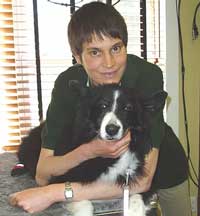
Overpopulation is the main driver behind early spay-neuter programs which, over the past 30 years, have become routine throughout the United States. In fact, since the 1970s, the “ultra-early” neutering of puppies and kittens has been the custom in many veterinarian offices due to the abundance of feral and abandoned animals being euthanized in shelters. Other reasons for the practice include the reduction of the risk of mammary cancer for female cats and dogs and testicular cancer in males.
Some veterinarians have called this practice into question over concerns of the effect these procedures have on animals’ long-term health. Dr. Alice Villalobos, DVM, raised this issue in an article published in Veterinary Practice News: “What if large-scale studies found that early neutering jeopardizes the health of our pets?” she posited. “What if we found enough epidemiological evidence that early neutering of pet dogs may open them to orthopedic, behavioral, immunologic, and oncologic issues?”
The Risks of Early Spay-Neutering in Dogs
Dr. Villalobos stated that while the data on felines is inconclusive, there is substantial epidemiologic evidence that the well-being of pet dogs may be jeopardized by early spay-neutering practices. One of the greatest concerns is that they may cause an increased risk of cancer, which counters earlier research that indicated doing so was a preventative measure for cancer in dogs.
However, as is often the case, the issue is not clear-cut. It appears that the practice of early spay-neutering may be preventative for some types of cancers in dogs and enhanced in others.
One study found female dogs spayed prior to one year of age to be at five times greater risk of hemangiosarcoma than intact ones. Hemangiosarcoma is a form of cancer often found in the spleen, but it can also be found in the liver, heart, muscles, skin, brain, omentum, and other locations throughout the body. This is of particular relevance for larger dogs, like golden retrievers and German shepherds. The same study also found the incidence of hemangiosarcoma to be close to two-and-half times greater in neutered versus intact male dogs. Increased risk for osteosarcoma (bone cancer) was also found in neutered dogs.
With regard to mammary cancer, the evidence shows an increased risk in female dogs with each heat cycle and high rates of malignancy in both dogs (30-50 percent of tumors) and cats (95 to 98 percent). This points to the protective factor spay and neutering can offer.
However, the issue is complicated and leads one to question: How do we reduce the risk of one potential illness without increasing the risk of others? Like hypothyroidism, infectious disease, urinary incontinence, and other types of cancer?
Revisiting the Optimal Age for a Spay-Neuter
Chris Zink DVM, PhD, has also pondered the health risks imposed by early spay and neutering. In “Early Spay-Neuter Considerations for the Canine Athlete: One Veterinarian’s Opinion,” she reviewed scientific evidence that, taken as a whole, may suggest that veterinarians “should revisit the current standard protocol in which all dogs that are not intended for breeding are spayed and neutered at or before six months of age.”
Dr. Zink’s examination of the research included a discussion of the adverse orthopedic consequences, heightened cancer risk, behavioral concerns (increases in phobias, aggression, undesirable sexual behaviors like mounting, fear, and reactivity), as well as other health risks like the ones cited by Dr. Villalobos.
In addition to increased risk for urinary incontinence and hypothyroidism, she cited a 22 percent increased risk of fatal, acute pancreatitis in neutered versus intact female dogs and a 27 to 38 percent increase in adverse reactions to vaccines in neutered versus intact dogs.
Ultimately, Dr. Zink similarly concluded that the issue of early spay and neutering practices is not black and white. She called for the need for more research on their effect before puberty and expressed her concern about the practice of gonad removal (testes in males, ovaries in females): “It is clear that the gonads are not just important for reproduction, but play a critical role in growth, development, and long-term health,” she wrote. However, she cautioned, sterilization has its own set of issues to consider. Ultimately, he argues for an individualized approach, taking into consideration what’s best for each individual animal.
What do integrative veterinary professionals recommend with regard to spay and neutering practices? Integrative doctor of veterinary medicine, Tina Aiken, generously shared her thoughts in an interview in May 2021.
A Voice from the Integrative Veterinary Medical Community, Dr. Tina Aiken, DVM

Dr. Tina Aiken, DVM is the owner of Integrative Animal Care in Ancramdale, NY where she has been providing conventional and alternative treatments for cats, dogs, and horses since 2005.
Raised in Cologne, Germany, Dr. Aiken’s parents were both involved in the medical field. This, along with her personal experience using homeopathy and nutrition to treat severe allergies in her teens, led her to the field of integrative veterinary medicine.
Dr. Aiken attended veterinary school in Hannover, Germany as well as in Utrecht, Holland and Cambridge, England as an exchange student. Before relocating to the United States in 1995, Dr. Aiken worked in a small animal and equine practice in the United Kingdom.
In sharing what an integrative approach to veterinary medicine entails, Dr. Aiken said that it involves treating the root cause of illness: “Symptom control is part of treatment,” she said, “as well as finding out what caused the ailment.”
What does an Integrative Approach to Spaying and Neutering Involve?
Dr. Aiken urges pet owners to refrain from early spay and neutering. “Puppies being spayed and neutered is so harmful,” she said. “It’s extreme on many levels.” While many of her clients come to her already spayed and neutered, she still speaks to pet owners about this issue: “Even if it’s too late, I try to mention it because [they] might get another dog. They might speak to other people who are trying to get a dog.”
Dr. Aiken’s stance stems from a serious objection to gonad removal in cats and dogs. Sterilization, she explained, is preferable to spay and neutering, especially in the early years of a pet’s life. Dr. Aiken advises, “You don’t want them to be spayed or neutered; you want to keep them intact. You can sterilize them, but they will still have their hormones.”
One of the main reasons Dr. Aiken cites, as mentioned earlier, is cancer risk:
There’s so much more cancer if you spay them earlier. So much more, like four times the rate of many cancers, some even nine times the rate. It’s huge, the difference. It’s not like 10 percent more or 20 percent. It’s 400 percent more. It’s a huge difference.
There’s a lot of talk about it, and many people choose to ignore it. It’s like “The Inconvenient Truth”…Some breeds are more affected than others…but I see the heartache, I see the animals dying young of cancer. Really young. I see the fear aggression, the imbalance.
But she added that this is going to require the voice of pet owners and adopters: “The shelters are not going to change their policy unless they hear from the bottom-up, from clients saying they want intact dogs.”
The Alternative to a Spay-Neuter: The Sterilization of Dogs and Cats
Sterilization without the removal of gonads gives animals access to their reproductive hormones throughout the course of their life cycle and the associated benefits. Dr. Aiken supports measures to prevent overpopulation and explained, “We can sterilize them without spaying and neutering…We don’t want unwanted puppies, but we don’t have to spay them. We can do vasectomies. We can do a partial spay or tubal ligation. So they still have all the hormones, they just can’t reproduce.
Different kinds of sterilization practices are available. In lieu of what is considered a “typical spay,” or ovariohysterectomy, during which the ovaries, uterus, and fallopian tubes are removed, another option is to perform an ovary-sparing spay. This is a hysterectomy only and entails removal of the uterus and all or part of the cervix while leaving the ovaries intact.
For male cats and dogs, instead of the “typical neuter” (orchiectomy), a vasectomy can be performed, during which the vas deferens is cut, but the testes remain intact.
What about the risk of cancer involved in leaving the gonads (especially in the case of female dogs and cats)? In lieu of early spay/neutering, Dr. Zink proposed sterilizing, and then removing the ovaries of female dogs and cats later in life. In the case of dogs, Dr. Aiken explains that,
Although the risk for mammary cancer probably is higher in intact females, most vets would agree that mammary cancer in dogs rarely kills the dog, but the affected females usually die of other causes. In my career, I have lost only a handful of bitches due to mammary cancer, but many, many more due to cancers that are way more common in spayed female dogs, like lymphosarcomas, osteosarcomas, mast cell tumors, and hemangiosarcomas.
For cats, however, this is a different story, Dr. Aiken asserts, as mammary cancer in cats usually is way more aggressive and often fatal.
Making Decisions for Your Pet
Dr. Aiken usually recommends spaying and neutering most cats, but as stated above, she has big concerns regarding the practice for dogs, especially with regard to puppies. She shared this advice for pet owners making decisions about spaying and neutering their animals:
You have to weigh all the pros and cons. But, definitely don’t get a puppy that’s already spayed and neutered. They should go through at least one, but better a couple of heat cycles. Males should be fully developed and fully grown if you’re considering neutering them, and not any earlier to reduce the chance of developmental disorder. There’s still the risk of cancer and other illness related to hormone imbalance, but at least if you wait, it won’t be as severe.
Counter to Dr. Zink and Dr. Aiken’s recommendations, the American Veterinary Medical Association (AVMA), however, suggests that it may not be wise to wait until after the first heat cycle.
However, before making decisions on the spay and neutering of an animal, be sure to consider the age, breed, and physical condition of your pet and consult your veterinarian concerning the best option—sterilization only or full spay/neuter—and the optimal time to do so.

